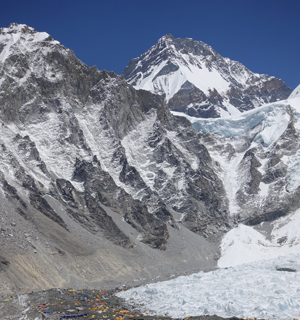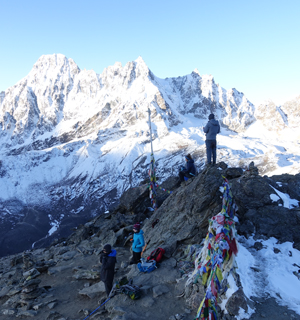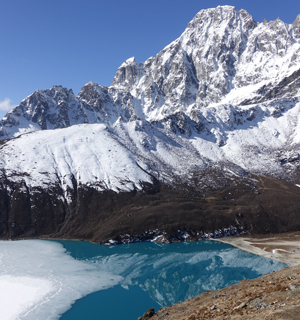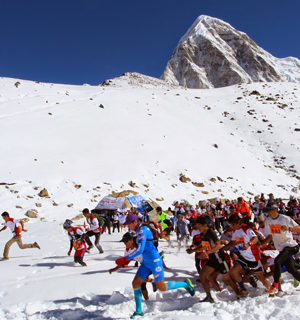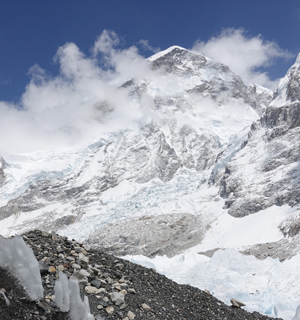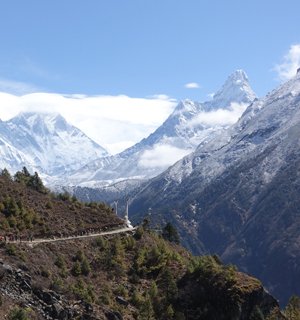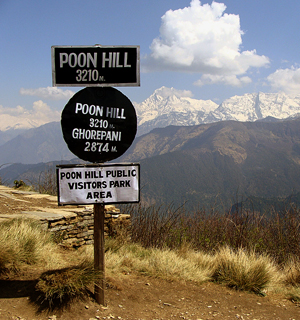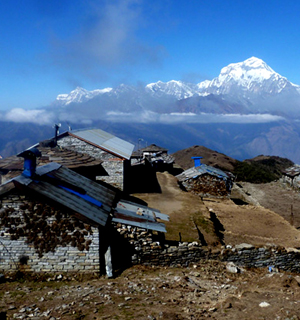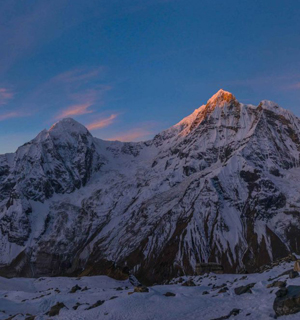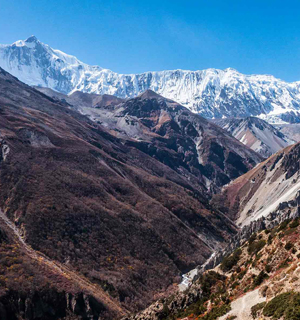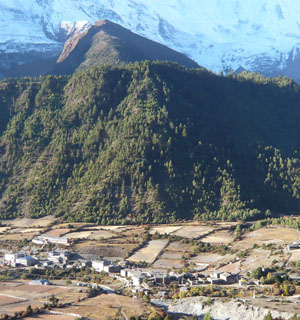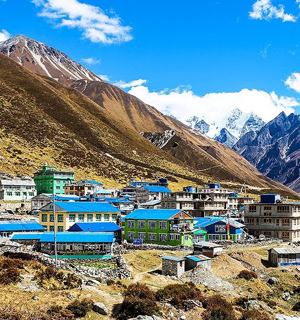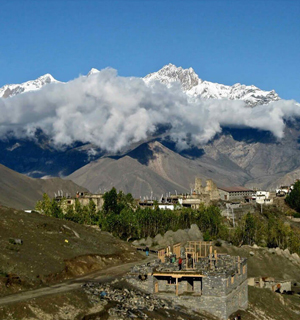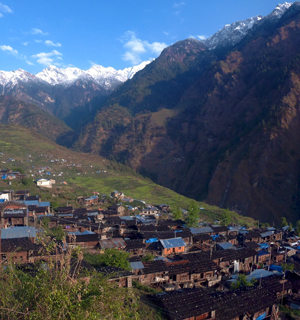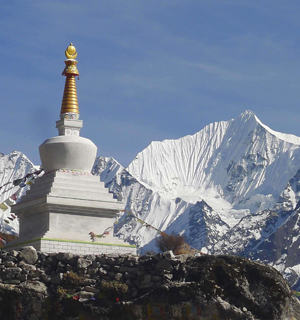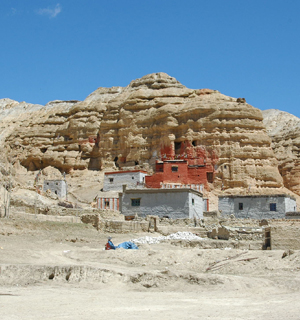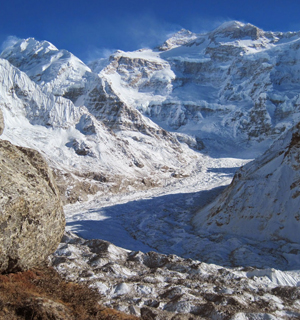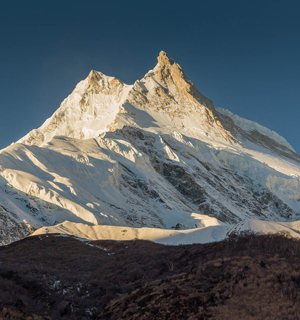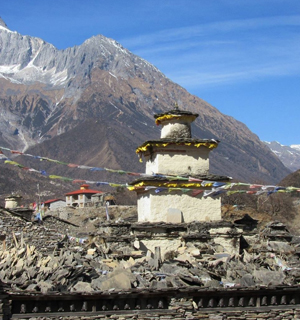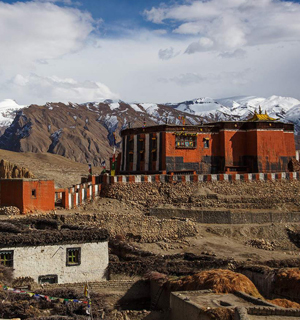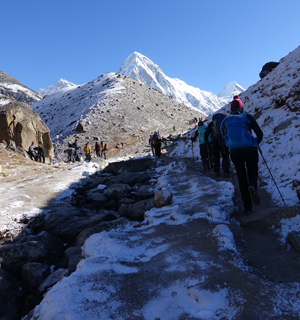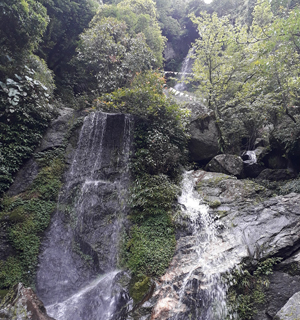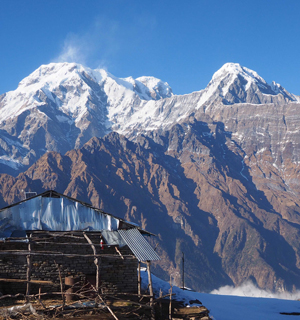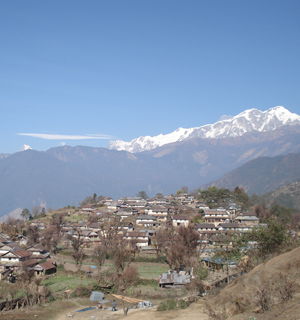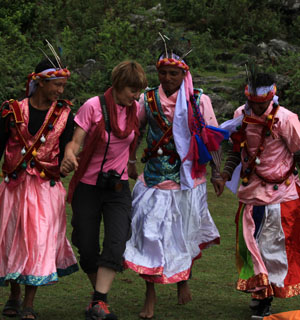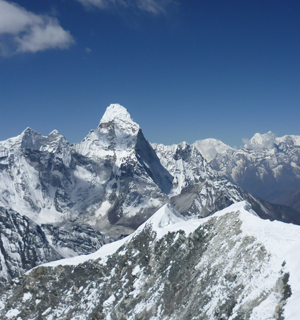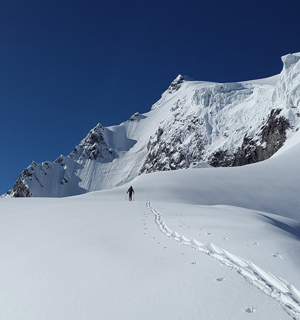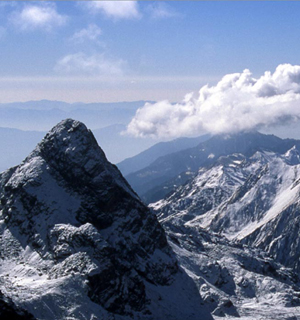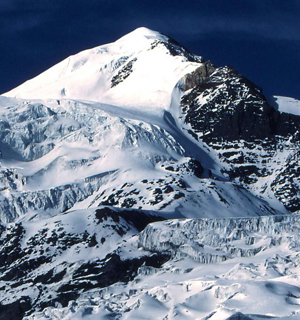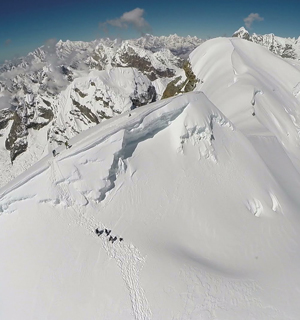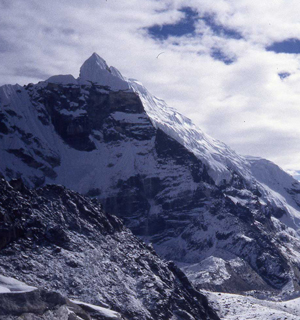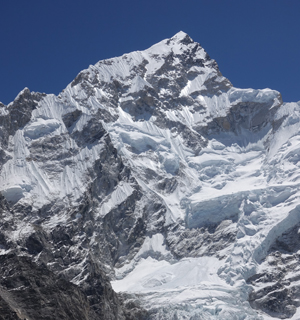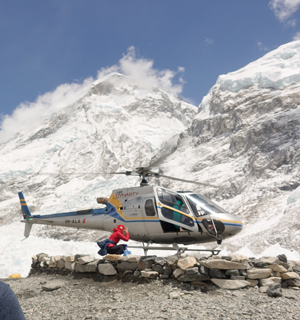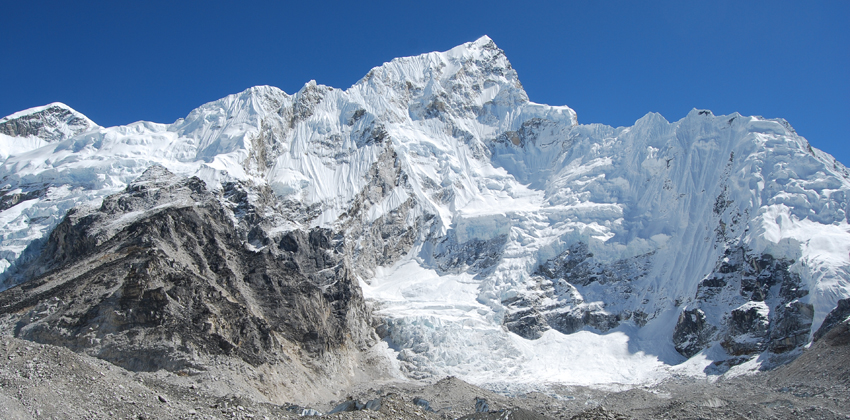
AMS - Acute Mountain Sickness
Acute Mountain Sickness (AMS) is a constellation of symptoms that represents your body not being acclimatized to its current altitude. As you ascend, your body acclimatizes to the decreasing oxygen (hypoxia). At any moment, there is an "ideal" altitude where your body is in balance; most likely this is the last elevation at which you slept. Extending above this is an indefinite gray zone where your body can tolerate the lower oxygen levels, but to which you are not quite acclimatized. If you get above the upper limit of this zone, there is not enough oxygen for your body to function properly, and symptoms of hypoxic distress occur - this is AMS.
Zone of Tolerance
Go too high above what you are prepared for, and you get sick.
This "zone of tolerance" moves up with you as you acclimatize. Each day, as you ascend, you are acclimatizing to a higher elevation, and thus your zone of tolerance extends that much higher up the mountain. The trick is to limit your daily upward travel to stay within that tolerance zone.
The exact mechanisms of AMS are not completely understood, but the symptoms are thought to be due to mild swelling of brain tissue in response to the hypoxic stress. If this swelling progresses far enough, significant brain dysfunction occurs (See next section, on HACE). This brain tissue distress causes a number of symptoms; universally present is a headache, along with a variety of other symptoms.
Signs
The diagnosis of AMS is made when a headache, with any one or more of the following symptoms is present after a recent ascent above 2500 meters (8000 fee)
- Loss of appetite, nausea, or vomiting
- Fatigue or weakness
- Dizziness or light-headedness
- Difficulty sleeping
All of these symptoms may vary from mild to severe. A scoring system has been developed based on the Lake Louise criteria; look at the AMS questionnaire for a simple method to evaluate an individual's AMS severity.
AMS has been likened to a bad hangover, or worse. However, because the symptoms of mild AMS can be somewhat vague, a useful rule-of-thumb is: if you feel unwell at altitude, it is altitude sickness unless there is another obvious explanation (such as diarrhea).
Anyone who goes to altitude can get AMS. It is primarily related to individual physiology (genetics) and the rate of ascent; there is no significant effect of age, gender, physical fitness, or previous altitude experience. Some people acclimatize quickly, and can ascend rapidly; others acclimatize slowly and have trouble staying well even on a slow ascent. There are factors that we don't understand; the same person may get AMS on one trip and not another despite an identical ascent itinerary. Unfortunately, no way has been found to predict who is likely to get sick at altitude.
It is remarkable how many people mistakenly believe that a headache at altitude is "normal"; it is not. Denial is also common - be willing to admit that you have altitude illness, that's the first step to staying out of trouble.
It is OK to get altitude illness, it can happen to anyone. It is not OK to die from it. With the information in this tutorial, you should be able to avoid the severe, life-threatening forms of altitude illness.
Prophylaxis
Under certain circumstances, prophylaxis with medication may be advisable
- for persons on forced rapid ascents (such as flying into Lhasa, Tibet, or La Paz, Bolivia), for climbers who cannot avoid a big altitude gain due to terrain considerations, or for rescue personnel on a rapid ascent
- for persons who have repeatedly had AMS in the past
Acetazolamide - Diamox
We do not recommend acetazolamide as a prophylactic medication, except under the specific limited conditions outlined above. Most people who have a reasonable ascent schedule will not need it, and in addition to some common minor but unpleasant side effects it carries the risk of any of the severe side effects that may occur with sulfonamides.
The dose of acetazolamide for prophylaxis is 125-250 mg twice a day starting 24 hours before ascent, and discontinuing after the second or third night at the maximum altitude (or with descent if that occurs earlier). Sustained release acetazolamide, 500 mg, is also available and may be taken once per day instead of the shorter acting form, though side effects will be more prominent with this dose.
Ginkgo biloba extract
Recently some exciting work has been done studying the use of Ginkgo biloba extract to prevent AMS. Much more work remains to be done, but in three studies Ginkgo has been shown to be very effective in preventing or lessening the symptoms of AMS. It has yet to be determined exactly how Ginkgo works at altitude, but it may act as an antioxidant, reducing stress on tissues that have been injured by low oxygen levels.
These studies used a standardized Ginkgo biloba extract (24% flavonoid glycosides, 6% terpenoids). The dose used was 80 - 120 mg twice a day, starting 5 days before a rapid ascent or at the beginning of a gradual ascent. ConsumerLab.com is an independent lab that tests herbal products to ensure that they contain what the label promises; they have a page evaluating Ginkgo products available in the USA.
AMS Medicine:
Acetazolamide (Diamox)
125-250 mg (depending on body weight; persons over 100 kg (220 lbs) should take the higher dose) twice a day starting 24 hours before ascent, and discontinuing after the second or third night at the maximum altitude (or with descent if that occurs earlier). Children may take 2.5 mg/kg of body weight twice a day.
Ginkgo Biloba Extract
80 - 120 mg twice a day, starting 5 days before a rapid ascent or at the beginning of a gradual ascent. tory depression (the slowing down of breathing) can be caused by various medications, and may be a problem at altitude. The following medications can do this, and should never be used by someone who has symptoms of altitude illness (these may be safe in persons who are not ill, although this remains controversial)
The Golden Rules for AMS
If you've been paying attention to the tutorial so far, these will be familiar. If there is a nugget of knowledge to take away from this tutorial, here it is:
GOLDEN RULE I:
If you feel unwell at altitude it is altitude illness until proven otherwise.
GOLDEN RULE II:
Never ascend with symptoms of AMS.
GOLDEN RULE III:
If you are getting worse (or have HACE or HAPE), go down at once.
Questioning Your Porters about AMS Symptoms
If you hire your own porters, please be aware that they are just as susceptible as you to the ravages of AMS. Porters may even be at increased risk of severe forms of altitude illness as they are unlikely to know anything about AMS, are more likely to have a communication barrier to telling you how they feel, and may actively hide their symptoms as they fear losing their job due to illness. For those of you who will be trekking in Nepal, please look at the AMS questionnaire with phonetic Nepali translations (based on the Lake Louise AMS scoring criteria). For more information, also look at the International Porter Protection Group's web site.
Diarrhea
Diarrhea is the number one medical complaint of travelers in the first 2 weeks away from home. It is prevalent in countries with underdeveloped water purification and sanitation systems, and it attacks nearly everyone who visits the Khumbu for any amount of time. BUT it is preventable if you are careful and practice good hygiene.
When you're sliding into first and you feel a something burst.
Bacterial infection is only one cause of diarrhea. Viruses, protozoa, certain medications, food intolerances, allergies are among the myriad other causes of this ailment. This important to remember, because there is no one pill that takes care of all of them. And if you indiscriminately take antibiotics (which only work on bacteria), you can actually make any of the other causes of diarrhea even worse by knocking out all of your body natural good bacteria. Diarrhea is a complicated problem, and if it persists for days or is associated with bleeding, fainting, severe dehydration, high fevers, severe pain, you should see a doctor for professional evaluation and treatment.
When you're sliding into second and you feel something beckon
Some people take prophylactic (preventative) medication to prevent diarrhea, but this may be a very risky practice. The potential side effects from some of these medications range from slightly annoying to deadly, not to mention the alteration of your natural bacterial flora and potential development of antibiotic resistance. You should make the decision to take prophylactic medications with your personal physician. I don,t advise it in most situations.
When you're sliding into third and you and you feel a little. . .
For climbers with diarrhea on Everest, higher camps provide even more hostile situations; stripping in the icefall or while roped at the Lhotse wall is inevitable at times, and memorable always. In 1997, a climber fell and was killed while doing his thing at C3. Always be carefully roped when leaving tent at C3, even for very short distances!
Diarrhea causes dehydration and disturbance of the mineral balance in your body. Drink plenty and add electrolyte supplement (ORS packets are widely available in Nepal.)
When you're sliding into home and you feel a burst of . . .
Since diarrhea is such a pain on Everest, sometimes you will have to take aids like Imodium to halt it. You should be careful with these aids though. If you have a bacterial infection, diarrhea is your body way of getting rid of the bad bacteria. Use Imodium or the equivalent only when you really have to.
Again, prevention is key:
- WASH YOUR HANDS after using the toilet and before eating.
- Treat your water with a good filter or by boiling or by using iodine
- Avoid raw food. Boil first or wash and peel before eating.
- Avoid unpasteurized dairy products.
- Avoid drinking products with ice that is made from untreated water.
HAPE - High Altitude Pulmonary Edema
Another form of severe altitude illness is High Altitude Pulmonary Edema, or fluid in the lungs. Though it often occurs with AMS, it is not felt to be related and the classic signs of AMS may be absent. Signs and symptoms of HAPE include any of the following:
- Extreme fatigue
- Breathlessness at rest
- Fast, shallow breathing
- Cough, possibly productive of frothy or pink sputum
- Gurgling or rattling breaths
- Chest tightness, fullness, or congestion
- Blue or gray lips or fingernails
- Drowsiness
HAPE usually occurs on the second night after an ascent, and is more frequent in young, fit climbers or trekkers.
In some persons, the hypoxia of high altitude causes constriction of some of the blood vessels in the lungs, shunting all of the blood through a limited number of vessels that are not constricted. This dramatically elevates the blood pressure in these vessels and results in a high-pressure leak of fluid from the blood vessels into the lungs. Exertion and cold exposure can also raise the pulmonary blood pressure and may contribute to either the onset or worsening of HAPE.
Immediate descent is the treatment of choice for HAPE; unless oxygen is available delay may be fatal. Descend to the last elevation where the victim felt well upon awakening. Descent may be complicated by extreme fatigue and possibly also by confusion (due to inability to get enough oxygen to the brain); HAPE frequently occurs at night, and may worsen with exertion. These victims often need to be carried.
It is common for persons with severe HAPE to also develop HACE, presumably due to the extremely low levels of oxygen in their blood (equivalent to a continued rapid ascent).
HAPE resolves rapidly with descent and one or two days of rest at a lower elevation may be adequate for complete recovery. Once the symptoms have fully resolved, cautious re-ascent is acceptable.
Summary of HAPE treatment
DESCENT, rest, oxygen, rehydration, and for severe cases, nifedipine, salmeterol. Nifedipine lowers the pulmonary hypertensive response to hypoxia, but is a prescription medicine for a good reason -- it may be hazardous to use without appropriate medical supervision and advice. Salmeterol is more commonly used as an asthma medication, but it also can hasten the body's ability to re-absorb edema fluid that clogs up the airways in HAPE. It is also a prescription medication in most of the world.
HAPE can be confused with a number of other respiratory conditions:
High Altitude Cough and Bronchitis are both characterized by a persistent cough with or without sputum production. There is no shortness of breath at rest, no severe fatigue. Normal oxygen saturations (for the altitude) will be measured if a pulse oximeter is available.
Pneumonia can be difficult to distinguish from HAPE. Fever is common with HAPE and does not prove the patient has pneumonia. Coughing up green or yellow sputum may occur with HAPE, and both can cause low blood levels of oxygen. The diagnostic test (and treatment) is descent - HAPE will improve rapidly. If the patient does not improve with descent, then consider antibiotics. HAPE is much more common at altitude than pneumonia, and more dangerous; many climbers have died of HAPE when they were mistakenly treated for pneumonia.
Asthma might also be confused with HAPE. Fortunately, asthmatics seem to do better at altitude than at sea-level. If you think it's asthma, try asthma medications, but if the person does not improve fairly quickly assume it is HAPE and treat it accordingly.
Khumbu cough
The relative humidity at high altitude is extraordinarily low, and almost invariably irritates the respiratory tract. The result is the infamous Khumbu cough, which can be serious enough to cause a person to cough hard enough to break a rib.
The best way to prevent it is to wear a mask that heats and moisturizes the air you breathe. A balaclava worn especially at night may be helpful. Many climbers use masks that can be found in cross-country ski stores. These masks have a metallic net inserted in a lightweight plastic or cloth shell and were originally developed for the Finnish Olympic ski team.
Frostbite/Hypothermia
Frostbite
Prevention is the key to avoiding frostbite. Here are some important reminders:
- Stay well hydrated and well fed to enable your body to generate heat!
- Avoid alcohol, which can impair your sensation (and judgment!)
- Avoid smoking, which will constrict your blood flow
- Don't climb/trek under extreme weather conditions (wind, very cold)
- Avoid tight fitted clothing, no wrinkles in the socks
- If your clothing/socks/gloves get wet from snow/rain or perspiration, DRY them quickly including boot insoles
- Wear mittens rather than gloves in extreme cold and a liner glove underneath if you need quick temporary access to fingers (e.g. photography)
- Never ignore numbness as an old professor once told me if you feel your fingers and toes getting numb and you ignore it, that numbness might be the last thing you ever feel! Numbness is a sign that you may be getting into trouble. If it doesn't resolve by increasing activity, you need to get somewhere to take off your gloves/boots and rewarm yourself.
- Avoid rubbing frostbitten areas beating on them only increases the chance of injury and doesn't help them rewarm faster.
- IF you or your buddy has frostbite, get somewhere warm, but only rewarm the injured area if there is no chance it will refreeze
Keep the area padded and protected against further heat loss. The quickest way to rewarm is to submerge in warm water (~104F, or the warmth of a hot tub, test the water first with a thermometer or an uninjured body part a frozen hand can't determine if the water is too hot!)
Hypothermia
Hypothermia can kill in mere minutes. Cold temperature, but also strong wind causes the body to rapidly lose heat. You start to shiver in order to maintain body heat from the rapid muscular shaking. If your body temperature drops to 35C/95F, you may get dizzy and disoriented, then the shivering stops. The body now maintains temperature only around the important organs; heart, brain and lungs and shuts down blood circulation to the arms and legs. Your pulse becomes weak and slow. Your blood vessels widen. Now, you feel hot and want to remove your clothes, finally slipping into unconsciousness. Eventually, your heartbeat stops.
Full blown Hypothermia will not be improved by additional clothing since clothing doesn't generate heat. In difficult climbing situations, you need to put hot water bottles in your armpits, to your crotch and/or stomach â?? or you can strip and get into a sleeping bag - together with another undressed person, to warm up by the others body heat (yeah, yeah - keep your dirty imagination to yourself!).
Otherwise - keep moving until at safety. In 1998, a climber died of hypothermia on the North Side. All that was found left of him was his clothing neatly folded below the summit. This is quite typical of the condition. Confused, the brain tries to bring some order in the situation, thus folding the clothes.
Again, prevention is key! Here are some tips:
- Stay well nourished to help your body produce heat and shiver effectively when needed.
- Stay well hydrated and well rested.
- Change wet inner garments promptly
- INSULATE! (head and neck are key!) great materials include Gore-Tex, Thinsulate, Flectalon
- Follow the C-O-L-D clothing principle:
- Clean
- Open when exercising to reduce sweating/wetness
- Loose/Layers to retain heat
- Dry to limit conductive heat loss
Heartburn
This is a very common complaint at altitude. I have found that visitors to the Khumbu end up drinking much more tea than they usually do at home. The usual tea brewed in this area is black tea that contains lots of tannin, which is abrasive and irritating to the stomach.
I encourage you to drink herbal tea (which also eliminates the diuretic effects of caffeine) many of my patients have had complete resolution of their heartburn when they gave up drinking so much of the local tea. Antacids may be helpful, and many find relieve with OTC ranitidine.
Prevention
Things to Avoid
Respiratory depression (the slowing down of breathing) can be caused by various medications, and may be a problem at altitude. The following medications can do this, and should never be used by someone who has symptoms of altitude illness (these may be safe in persons who are not ill, although this remains controversial)
- Alcohol
- Sleeping pills (acetazolamide is the sleeping tablet of choice at altitude)
- Narcotic pain medications in more than modest doses
Preventing AMS
The key to avoiding AMS is a gradual ascent that gives your body time to acclimatize. People acclimatize at different rates, so no absolute statements are possible, but in general, the following recommendations will keep most people from getting AMS.
- If possible, you should spend at least one night at an intermediate elevation below 3000 meters.
- At altitudes above 3000 meters (10,000 feet), your sleeping elevation should not increase more than 300-500 meters (1000-1500 feet) per night.
- Every 1000 meters (3000 feet) you should spend a second night at the same elevation.
Remember, it's how high you sleep each night that really counts; climbers have understood this for years, and have a maxim "climb high, sleep low". The day hikes to higher elevations that you take on your "rest days" (when you spend a second night at the same altitude) help your acclimatization by exposing you to higher elevations, then you return to a lower (safer) elevation to sleep. This second night also ensures that you are fully acclimatized and ready for further ascent.
Preventing Severe AMS
This simply cannot be emphasized too much. If you have symptoms of AMS, DO NOT ASCENDS ANY HIGHER. Violating this simple rule has resulted in many tragic deaths.
If you ascend with AMS you will get worse, and you might die. This is extremely important - even a day hike to a higher elevation is a great risk. In many cases of High Altitude Cerebral Edema, this rule was violated. Stay at the same altitude (or descend) until your symptoms completely go away. Once your symptoms are completely gone, you have acclimatized and then it is OK to continue ascending. It is always OK to descend, you will get better faster.
arbon Monoxide poisoning
Carbon monoxide (CO) poisoning within tents and snow caves is a real and probably overlooked problem. It is potentially an even greater problem at altitude because of the multiplicity of risk factors for CO toxicity. Despite multiple anecdotal reports of climbers perishing from CO poisoning on Himalayan peaks circulating in climbing circles, the danger does not appear to be widely recognized.
Diagnosing CO poisoning in the early stages may be difficult because of the nonspecific nature of symptoms and (at altitude) their similarity to AMS. The masking of symptoms when subjects are sedentary exacerbates the problem, and these are likely to be the occasions when individuals are subjected to the highest CO levels, such as resting and cooking in tents for hours during inclement weather. All attempts must be made to prevent CO concentration from reaching dangerous levels; safety can be enhanced by the use of small portable CO detectors.
Summary of risk factors (and proposed precautions) for carbon monoxide poisoning in tents:
-- Cooking (Avoid prolonged simmering, keep stove highly pressurized, use white pure fuels, use small diameter pans, use maximal blue flame and avoid low flames)
-- Yellow flame (Turn stove off, repressurize, relight, and maximize tent ventilation for a few minutes)
-- Inadequate tent ventilation (Ventilation area at least 50cm2, CO egress port as high as possible, O2 ingress port as low as possible, higher risk in zero wind conditions)
-- Insidious onset of symptoms if sedentary (beware headache and fast heart rate, make regular trips outside to unmask symptoms, ventilate tent at regular intervals, ventilation does not have to be continuous)
-- Dehydration (stay well hydrated)
-- Snow holes tend to be worse than tents (beware of all of the above)
-- Hyperventilation (more exposure to CO)
-- High altitude
- -Tent icing and snow cover (makes tent less porous -- keep cleaned to allow air flow)
High Altitude Medicine
Definition of High Altitude
- High Altitude: 1500 - 3500 m (5000 - 11500 ft)
- Very High Altitude: 3500 - 5500 m (11500 - 18000 ft)
- Extreme Altitude: above 5500 m
he Body reaction to altitude
Certain normal physiologic changes occur in every person who goes to altitude:
- Hyperventilation (breathing faster, deeper, or both)
- Shortness of breath during exertion
- Changed breathing pattern at night
- Awakening frequently at night
- Increased urination
As one ascends through the atmosphere, every breath contains fewer and fewer molecules of oxygen. One must work harder to obtain oxygen, by breathing faster and deeper. This is particularly noticeable with exertion, such as walking uphill. Being out of breath with exertion is normal, as long as the sensation of shortness of breath resolves rapidly with rest. The increase in breathing is critical. It is therefore important to avoid anything that will decrease breathing, e.g. alcohol and certain drugs. Despite the increased breathing, attaining normal blood levels of oxygen is not possible at high altitude.
Credit to Dr. Tom Dietz of the ISMM for the original document edited to fit this webpage.
Sleeping Pills
Almost everyone has trouble sleeping at high altitude (see the section on altitude acclimatization for further explanation.) Most sleeping pills, however, can be dangerous and actually predispose you to altitude sickness.
If you re acclimatizing, acetazolamide can help a lot with the periodic breathing that disturbs sleep. Melatonin is an OTC sleep aid that helps many and has no contraindications at altitude. One prescription sleep aid that has shown NOT to disturb breathing at sleep is zoldipem; you may want to discuss taking this medication with your personal physician. Any other hypnotics/tranquilizers should probably not be used at altitude.
Cheyne stokes breathing
Persistent increased breathing results in reduction of carbon dioxide in the blood, a metabolic waste product that is removed by the lungs. The build-up of carbon dioxide in the blood is the key signal to the brain that it is time to breathe, so if it is low, the drive to breathe is blunted (the lack of oxygen is a much weaker signal, and acts as an ultimate safety valve). As long as you are awake it isn't much trouble to consciously breathe, but at night an odd breathing pattern develops due to a back-and-forth balancing act between these two respiratory triggers. Periodic breathing consists of cycles of normal breathing which gradually slows, breath-holding, and a brief recovery period of accelerated breathing.
This is not altitude sickness
The breath-holding may last up to 10-15 seconds. This is not altitude sickness. It may improve slightly with acclimatization, but does not usually resolve until descent.
Periodic breathing can cause a lot of anxiety:
- In the person who wakes up during the breath-holding phase and knows he has stopped breathing.
- In the person who wakes up in the post-breath-holding hyperventilation (recovery) phase and thinks he's short of breath and has High Altitude Pulmonary Edema (HAPE).
- In the person who wakes up and realizes his neighbor has stopped breathing.
In the first two cases waiting a few moments will establish a normal breathing pattern. In the final case, the sleeping neighbor will eventually take a breath, though periodic breathing cycles will likely continue until he or she is awake. If periodic breathing symptoms are troublesome, a medication called acetazolamide may be helpful. Dramatic changes take place in the body's chemistry and fluid balance during acclimatization.
The osmotic center, which detects the "concentration" of the blood, gets reset so that the blood is more concentrated. This results in an altitude diuresis as the kidneys excrete more fluid. The reason for this reset is not understood, though it has the effect of increasing the hematocrit (concentration of red blood cells) and perhaps improving the blood's oxygen-carrying ability somewhat; it also counteracts the tendency for edema formation. It is normal at altitude to be urinating more than usual. If you are not, you may be dehydrated, or you may not be acclimatizing well.
HACE - High Altitude Cerebral Edema
AMS is a spectrum of illness, from mild to life-threatening. At the "severely ill" end of this spectrum is High Altitude Cerebral Edema; this is when the brain swells and ceases to function properly. HACE can progress rapidly, and can be fatal in a matter of a few hours to one or two days. Persons with this illness are often confused, and may not recognize that they are ill.
The hallmark of HACE is a change in mentation, or the ability to think. There may be confusion, changes in behavior, or lethargy. There is also a characteristic loss of coordination that is called ataxia. This is a staggering walk that is similar to the way a person walks when very intoxicated on alcohol. This loss of coordination may be subtle, and must be specifically tested for. Have the sick person do a straight line walk (the "tandem gait test"). Draw a straight line on the ground, and have them walk along the line, placing one foot immediately in front of the other, so that the heel of the forward foot is right in front of the toes behind. Try this yourself. You should be able to do it without difficulty. If they struggle to stay on the line (the high-wire balancing act), can't stay on it, fall down, or can't even stand up without assistance, they fail the test and should be presumed to have HACE. (The formal diagnostic definition is here)
Descend immediately
Immediate descent is the best treatment for HACE. This is of the utmost urgency, and cannot wait until morning (unfortunately, HACE often strikes at night). Delay may be fatal. The moment HACE is recognized is the moment to start organizing flashlights, helpers, porters, whatever is necessary to get this person down. Descent should be to the last elevation at which they woke up feeling well. Bearing in mind that the vast majority of cases of HACE occur in persons who ascend with symptoms of AMS, this is likely to be the elevation at which the person slept two nights previously. If you are uncertain, a 500-1000 meter descent is a good starting point. Other treatments include oxygen, hyperbaric bag, and dexamethasone. These are usually used as temporizing measures until descent can be affected (see physician section for more details).
People with HACE usually survive if they descend soon enough and far enough, and usually recover completely. The staggering gait may persist for days after descent. Once recovery has been complete, and there are no symptoms, cautious re-ascent is acceptable.
Hydration
Although there are a variety of altitude hazards to your health and many ways to prevent and cure - especially by knowledge and good commonsense - there is one single important health tip that can help you avoid all sorts of health problems it can completely alter your performance in trekking/climbing as well as your ability to acclimatize and deal with altitude. It is very simple yet crucial â?? it is the drinking of water.
Simple as that. Drink. Drink, Drink! Staying hydrated equips you to acclimatize, exercise better, fight off hypothermia and frostbite, constipation, diarrhea .so plan to drink a minimum of 3 liters per day at rest, add more as needed for exertion and other losses (eg if you are working hard and sweating you may need up to 8 liters, or if you are ill with vomiting or diarrhea and losing lots of fluids, you will need to replace those losses too.) One or two hours before trekking/climbing, try to drink 1-2 liters to fill your tank-- some find that they continue to drink more while active if they use an easily accessible hydration hose system (an example of a commercial system Camelback these prevent the hassle of reaching for a bottle the hose is right next to your mouth!)
The best way to check that you are well hydrated is to check your urine. You need to drink until it clear and straw colored. Deep yellow/amber urine color usually means you are concentrating and need more water. If you aren't waking up at least once at night to urinate at altitude, you probably aren't drinking enough.
Finally - remember that coffee, tea and chocolate contain caffeine, which is a diuretic and won't do the work well. Count in only 50% liquid value with these.
Snow blindness
Snow blindness or solar/ultraviolet keratitis is an excruciatingly painful state that comes from the sun burning the covering of your eye -- the cornea. And it happens, very commonly if you don't wear sunglasses, or if you don't wear appropriate sunglasses in any bright light situation especially easy to encounter at altitude.
A sunny day on fresh snow can be beautiful, but incapacitating if you Ãre not protected. Keep in mind that the brightness can exceed 10-15 times the amount of light that is safe and comfortable for your eyes to accommodate.
Sometimes, when climbing on oxygen, the warm and moist breathing air will escape your oxygen mask upwards and sometimes clog up your goggles, especially upon climbing down. Your choice will then be to climb "blindfolded" or remove the glasses. You might choose to pull your glasses a bit out from your face, allowing the warm air to pass them. The suns rays will now be able to burn your eyes at the unprotected sides. An anti-fog lens cleaner may help in this situation.
If the weather is overcast you might be tempted to remove the glasses altogether. Yet the rays are just as harmful when cloudy, and the following morning you' ll be sorry. After 8 years of climbing it finally happened to us. It took only a short time without goggles at our summit descent (shooting film), we noticed nothing, and in the morning we were a mess.
Here are some guidelines to use when choosing a good trekking/mountaineering pair of sunglasses:
- 99-100% UV absorption
- Polycarbonate or CR-39 lens (lighter, more comfortable than glass)
- 5-10% visible light transmittance
- Large lenses that fit close to the face
- Wraparound or side shielded to prevent incidental light exposure
Good Medical Kit
What's in a Good Medical Kit?
You need to plan ahead to organize your personal medical equipment for a rigorous high altitude expedition whether you're climbing or trekking, dedicate some forethought to researching the local risks, potential disease exposures, and typical injuries you may encounter. No matter how much equipment you decide to bring, you cannot possibly prepare for every eventuality.
So, what should you take?
Minimalists might say, "Nothing but a triangular bandage and Swiss army knife," and others might assemble a collection that would stagger a porter. Remember, overly bulky kits are often left behind.
The contents of a kit depend on many on many factors:
- Environmental extremes
- Endemic diseases (i.e. rabies, malaria, etc)
- Your medical expertise
- Length of trip
- Availability of rescue (i.e. helicopter)
- Distance from definitive medical care
Personal Medical Kits
Each expedition member should carry his/her own personal kit; consider including these basic (but VERY IMPORTANT!) items:
- Non-narcotic pain relievers (acetaminophen or paracetamol, ibuprofen)
- Anti-inflammatories (ibuprofen)
- Throat lozenges
- Sunscreen and lip protection
- Minor wound care supplies:
- betadine or iodine type disinfectant solution
- bandaids
- moleskin or favorite blister remedy
- tape
- nonstick bandages
- antibiotic ointment
- Insect repellent if you travel through warmer climates en route
- Malaria prophylaxis prescription medications (if risk exists during your travel to altitude)
- Anti-diarrheal medication (loperamide is good)
- Antacids
- Anti-oxidant vitamins
- ORS (oral rehydration solution) available in small packets to be reconstituted with water, provides electrolytes for replacing losses from vomiting/diarrhea
- Personal medications (for pre-existing problems)
- For women, supplies for menstrual flow.
